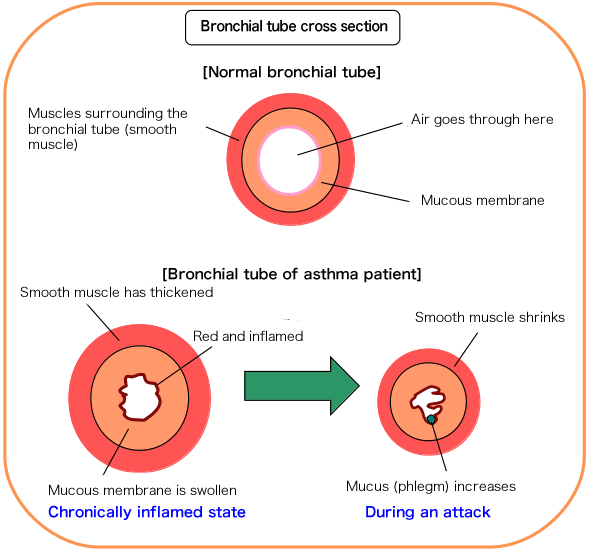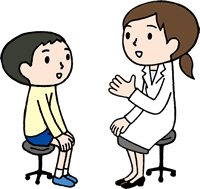Childhood asthma
Last updated on: 20 April 2022 | Released on: 21 April 2017
What is childhood asthma?
Asthma is an allergic disease of the respiratory tract. House dust, pet dander, cigarette smoke, vigorous exercise, or viral infections can cause your bronchi to contract and your mucous membranes to swell, producing more mucous and phlegm resulting in narrowed airways. Asthma causes wheezing and/or coughing and breathing difficulties when serious. One characteristic of this condition is the repeated bouts of asthmatic attacks. These attacks may subside spontaneously or with the help of bronchial dilators, but may sometimes require emergency treatment or hospitalization, and in rare cases may be life-threatening.
Another thing to keep in mind is that the airway (trachea/bronchi) inflammation is always there, even when you have no attack symptoms. You are constantly at risk of an asthmatic attack, which may strike at any time. Treating this chronic airway inflammation will allow you to live your life free of asthma attacks.
During infant period, about 40% of children experience wheezing after catching a cold, and are diagnosed as asthma or possible asthmatic. However, only around 10% of children are confirmed as asthma at the time of entering elementary school, then the percentage gradually decreases as their ages rise.

Factors which may cause or trigger an asthma attack
As for the asthma patient, his/her respiratory mucosa become so sensitive that it reacts with various stimuli. The main causes are shown in the followings. You can prevent asthmatic attacks by knowing what cause may raise an asthma attack.
- Smoke from cigarettes or fireworks
- Inhaled allergens (dust mite droppings and carcasses, house dust, mold, animal fur and dander, insect parts, pollen, etc.)
- Viral or other respiratory tract infections
- Climate or weather conditions (seasonal changes or severe weather conditions such as typhoons)
- Strenuous exercise (exercise-induced asthma)
- Stress
Diagnosis
A person is diagnosed as asthma when he/she has experienced repeated breathing difficulties accompanied by wheezing.
(1) Medical interview

- Since when?
- Symptoms
- When does coughing occur?
- What kinds of sounds? (Wheezing, whistling sounds, etc.)
- Frequency
- Intensity of coughs (can’t sleep, can’t speak, difficulty breathing)
- Symptoms other than coughs
- Allergies other than asthma (allergic rhinitis, hay fever, atopic dermatitis, food allergies, etc.)
- Allergy in the family (related by blood)
- Description of any treatment currently underway (any medication and how long the patient has been taking it)
The above are some questions you will be asked. We recommend you have the answers written down and ready when you see the doctor.
(2) Tests
The following tests may be performed to diagnose asthma or distinguish between asthma and other illnesses.
- Blood test / Skin test -> To determine whether the patient is prone to allergies, and if so, what the allergens are.
- Plain chest X-ray -> To see if there are any structural abnormalities in the chest and bronchi.
- Respiratory function test / Airway reversibility test / Airway resistance measurement -> To identify the characteristics of the patient’s asthma and measure the narrowness of the airway.
- Exhaled nitric oxide (NO) test -> To measure the degree of airway inflammation and damage.
- Airway hyperresponsiveness test -> To measure how sensitive the airway is to stimuli.
Severity
The severity of asthma is judged by the severity of symptoms and the frequency of their occurrence. It is important for you to monitor the severity and frequency of asthma symptoms, because the doctor will prescribe medication upon identifying the severity of the asthma. If the patient is already receiving treatment, the severity of asthma will be determined by how symptoms present and how the asthma medication is being used.
Next: TreatmentTreatment
The ultimate goal of childhood asthma treatment is to achieve remission (a state where the patient has no symptoms even though he or she is not being treated with medication etc.) and cure. However, the goals of day to day treatment are:
- Improving symptom control;
- Normalizing breathing function; and
- Improving the patient’s quality of life.
Through the above, the goal is to allow the child to be free from asthma attacks and live a normal life like a healthy child.
To do so, it is important not only to control the immediate attack, but also to prevent the next attack from occurring. Therefore, treatment must be continued even after symptoms have settled down. The following 3 points are important for asthma treatment.
Basics of treatment
- Medication: Regular medication and inhalation with the doctor’s guidance
- Environmental management: Patient and family work together to reduce irritants and triggers from the living environment
- Self-care: Patient takes an active part in his/her treatment, acquiring the knowledge and judgment required to continue proper management
Medication (Regular medication and inhalation with the doctor’s guidance)
Asthma medicines come in two types: Medicines for long-term control, and quick-relief medicines to treat asthma attacks.
Long-term asthma control medications
These include steroid medications which are inhaled even when your child has no symptoms, to soothe inflammation of the airway and prevent attacks.
Even when your child has no symptoms, his or her airway is inflamed. Just like daily toothbrushing prevents cavities, it is important to relieve airway inflammation by daily, regular use of long-term asthma control medications (such as inhaled steroids).
Quick-relief medications
You use quick-relief medicines to help relieve asthma symptoms when they happen. They come in forms such as inhalers and tablets. Inhalers act more quickly, because they deliver the medicine directly to your child’s airway. However, these quick-relief medicines only relieve symptoms temporarily. To ensure proper, day to day control of your child’s condition, it is important to use a long-term asthma control medication every day on a regular basis, to keep airway inflammation down over the long term. This will help prevent attacks.
Antibody agents
Injections (antibody agents) may be considered for severely ill patients with poorly controlled asthma despite sufficient long-term management. Currently, there are 3 antibody agents which are covered by insurance for pediatric asthma. These are Xolair, Nucala, and Dupixent. Which antibody agent to use will be determined in consideration of the patient’s characteristics (age, build, allergy complications, etc.) and test findings. These are expensive drugs, but they may be dramatically effective. We recommend you consult your doctor.

